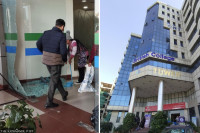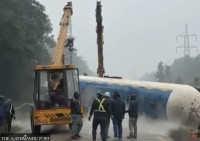National
How 2-day weekend could add to case backlog, impacting justice delivery
Nepal’s courts are burdened with a huge pile of cases.
Tika R Pradhan
The Supreme Court for years has been trying to ease the burden of backlog cases, some pending for more than five years. As of Monday’s data, there were 17,529 cases pending for more than two years and 4,819 cases that are older than five years.
There are close to 29,991 backlog cases.
According to officials at the Supreme Court, on an average, 70 cases are heard in a day but on Fridays the number is fewer. Last Friday only 61 cases were heard.
Now that the government has enforced a two-day weekend starting May 15, the court is set to get clogged even more. If 65 cases per day are taken into account, as many as 3,380 cases cannot be heard in a year, adding to the caseload of an already overwhelmed Supreme Court.
A report by Justice Hari Krishna Karki in July 2021 also pointed out that the Supreme Court is overburdened by cases as old as two decades.
Experts say the two-day weekly holiday system is going to increase backlog cases, which will affect the public’s right to justice. According to them, justice delivery alone is not enough in a country that believes in rule of law; for justice to be meaningful, it must be delivered on time.
Officials at the Supreme Court say the case-settlement rate had gone down for two years after the Covid pandemic hit the country. Then in October last year, justices launched an agitation, refusing to hear cases. Then lawyers joined in the justices’ protest. The imbroglio hugely affected hearings. Months after the benches resumed fully, the government introduced the two-day public holiday rule.
In April, Sushil Koirala, a joint secretary at the Law Ministry, who led a seven-member study panel to find ways to decrease the existing caseload, had presented a report to the then law minister Dilendra Badu.
According to the report, the caseload of the Supreme Court is 3,347 per bench, compared to 706 per bench at high courts and 743 for each of the district court judges.
Nepal’s judge to population ratio is one of the worst in the world, with just 15 judges per one million people.
The Supreme Court currently has 19 judges and 10 benches, as Mira Khadka has retired and Chief Justice Cholendra Shumsher Rana remains suspended since February 13.
There are a total of seven High Courts with 18 benches [seven permanent and 11 temporary] across the country, which have a total of 160 judges. Currently the positions for five chief judges and 19 judges are vacant, according to Man Bahadur Karki, spokesperson for the Judicial Council Nepal.
In 77 district courts, there are a total of 287 judges. Currently 43 district judges positions are vacant.
The Koirala-led panel’s report has made a number of recommendations for settling the cases quickly and efficiently, including determining the duration for benches and strictly implementing it; setting a time limit to manage hearings, making arrangements for having only one lead lawyer; classifying cases on the basis of their importance; and adopting a system of hearing them continuously.
It is not that Nepal’s chief justices are not aware of the high number of pending cases at the Supreme Court.
On Sunday, while speaking at a function organised by the Nepal Bar Council, acting Chief Justice Deepak Kumar Karki said that after he took over, the case clearance rate increased from 8 percent to 15 percent.
“When I took over the leadership, the clearance rate of backlogs stood at 8 percent. But I have increased it by two percentage points every month and now it has reached 15 percent as of yesterday [Saturday],” said Karki at the function on Sunday. “There have been complaints that the backlog cases are more at the Supreme Court compared to district and high courts. Since many cases remain to be disposed of, we are working to improve it.”
Karki became acting chief justice on February 13 after Rana's automatic suspension following the registration of an impeachment motion by 98 lawmakers in Parliament.
According to an official at the Supreme Court, the benches that used to start hearing cases at 11am, these days begin at 10:30am and the closing time has been increased by half an hour from 4:30pm to around 5pm. This has resulted in an increase of one hour of work for five days.
Observers, however, say that barely scratches the surface as the court does not hear a single case on Sundays.
Balaram KC, a former justice at the Supreme Court, said opening the benches half an hour early and closing them half an hour late won’t help in case clearance rate.
“The two-day work off will certainly lead to a rise in backlog cases,” said KC. “Anyway in Nepal, service seekers on Fridays are often told to visit the office on Sundays, which effectively means no work on Fridays.”
According to former chief justice Anup Raj Sharma, the two days of holiday effectively means three days of holiday, as there has been a tendency across the government offices, including the courts, to consider Friday as “half day.”
The five-day work policy was implemented in the Supreme Court in the past too.
According to former justices, during the time of the then chief justice Bishwanath Upadhyaya [1991-1995], the Supreme Court had declared two days of holidays. The objective then was allowing justices Sundays to write their decisions.
But it was not practised even for six months.
“The two-day holiday is already a failed practice,” said KC. “The judiciary must not rely on the trial and error method.”
This time’s two-day holiday system, however, is not implemented by the Supreme Court on its own, as the policy was declared by the government.
According to Sharma, having a five-day work schedule can be termed good only if it increases efficiency.
Officials say they are aware of the pending cases at the Supreme Court and that they are working to reduce the caseload. Some of the measures being discussed are diverting cases to lower courts.
Koirala, the joint secretary at the Ministry of Law, Justice and Parliamentary Affairs, said the government is working to amend some laws so that some cases coming to the Supreme Court could be finalised by high courts and other specialised courts like the Special Court, Administrative Court, Labour Court and some tribunals–Foreign Employment, Revenue and Debt Recovery.
“We are trying to lessen the burden of the Supreme Court and increase the capacity of the existing specialised courts,” Koirala told the Post. “We have not recommended amending constitutional provisions yet, but have proposed revising as many as 24 existing laws for the purpose.”
The number of justices for the Supreme Court has been fixed by the constitution.
Article 129 (1) of the constitution says that the Supreme Court shall consist of a maximum of 20 Judges, in addition to the chief justice.
Sharma, the former chief justice, said there is a need to have a proper and detailed study to know why the number of backlog cases has been rising. The judiciary then should try to find out what measures can be taken to increase the case clearance rate, according to him.
The judiciary is the only institution in Nepal that remains closed for a longer period of time compared to other government institutions. The Supreme Court is closed for a straight 15 days during the Dashain festival while other government offices remain closed for four-five days.
According to the Home Ministry, the number of annual public holidays after the government’s decision to enforce a two-day weekend has increased to 136 days from the previous 84, which includes 32 public holidays including religious holidays.
There are already some holidays for judges—earned leaves or casual leaves or medical ones.
Observers say Nepal’s judiciary has already been facing controversy and it could face more crisis—a crisis of credibility—if it continues to have pending cases piled up. Settling cases on a timely basis not only helps maintain the rule of law but also ensures swift justice delivery, the people’s fundamental right guaranteed by the constitution.
“All of us know that failure to provide justice on time amounts to denial of justice,” said KC, the former justice at the Supreme Court. “But not much has been done towards reducing backlog cases.”




 12.12°C Kathmandu
12.12°C Kathmandu













%20(1).jpg&w=300&height=200)

